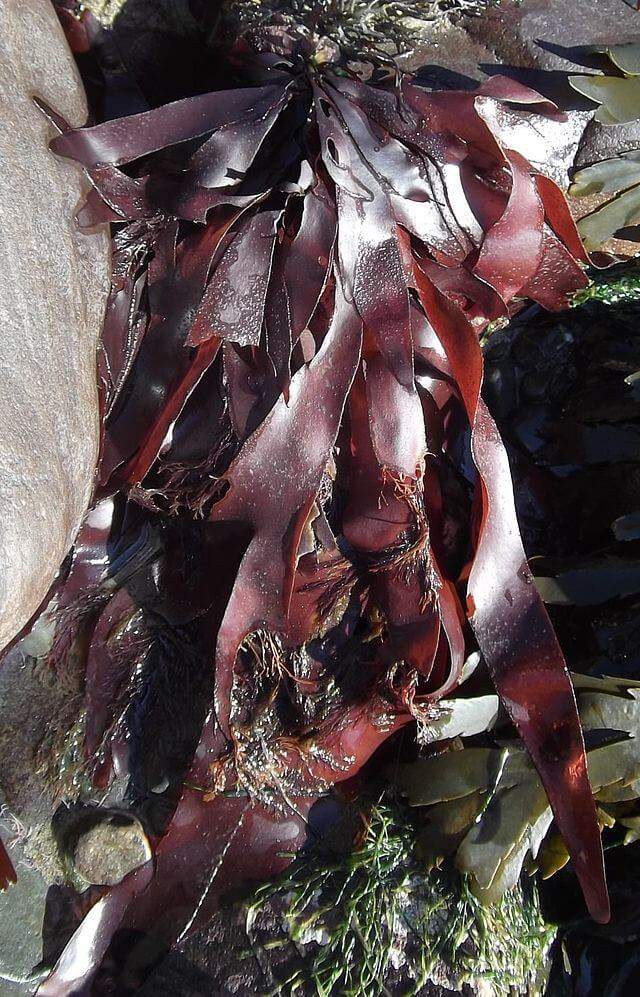Growing in cold coastal waters from the eastern shore of Canada to New Jersey, USA, dulse (Palmaria palmata) is a nutrient dense saltwater alga. This seaweed, also known as red seaweed and dillisk, is notable for is dark reddish hue and its unusual preferred growing place—on submerged rocks. Dulse prefers to grow in areas with strong currents, making it a perfect food to forage for in wading waters. Foragers will have their work cut out for them, though, as dulse must be picked carefully by hand during the short few hours of low tide.
Dulse’s two distinct characteristics, its color and habitat, significantly aid in identifying the alga. With a dark brown and purple hue when freshly harvested, dulse can also be identified by its divided lobes and flat fronds with irregular branching. This seaweed grows anywhere from a half foot to one and a half feet in length. Almost like a parasite, but with no ill side effects, dulse has also been known to latch itself to other underwater plants, so you may get lucky if your coastal waters aren’t very rocky. The best way to harvest this species of algae is to scurry along exposed rocks during low tide, especially the extra low tide during a new moon.

Edibility and Culinary Use
Dulse, like many seawater plants, is very salty. However, it is considered to have a mild flavor compared to other types of seaweed. It is a particularly valuable source of food for foragers, as it is incredibly nutrient dense and available for harvest year-round. Freshly harvested dulse has a chewy and rubbery texture and can be eaten raw, but the most common culinary uses call for dried dulse—usually achieved by drying the plant in the sun. Due to the algae’s natural gelatin content, dried dulse is frequently used as a thickener for soups, stews, and even baking. Its inherent saltiness also makes it a wonderful additive for rice dishes. Many consider dulse to have a strong umami flavor, and it has gained a popular reputation as ‘vegetarian bacon.’
Medicinal Uses of Dulse
A candidate to be labeled as a superfood, dulse is high in many nutrients—iodine, vitamin B6, iron, potassium, protein, and fiber, to name a few. It is regarded as a precious defense against iodine deficiency and a valuable food for preventing goiters. Dulse’s dense nutrient profile is rumored to give it anti-inflammatory properties, and some believe it can be used to prevent high cholesterol. This alga was vital for the prevention of scurvy in early American settlers.

Cautions
Demand for dulse has skyrocketed over the past few years, threatening the wild dulse population. When foraging, be sure to take only a few fronds from each plant, taking care to leave its root system intact so that it can regenerate. Also, it is always wise to check for chemical run off near your harvesting grounds to prevent accidental chemical ingestion. Dulse’s closest lookalike is laver (Porphyra yezoensis) due to its similar reddish hue. Laver, however, is also an edible seaweed! As with all iodine-rich foods, take care to consume dulse in moderation. Ingesting too much iodine can wreak havoc on your thyroid and result in permanent damage to your hormonal system.
Conclusion
Algae has long been accepted as a superfood for humans, and dulse doesn’t disappoint. With its rich history of feeding our ancestors and its demand for potential health benefits today, it is a food source foragers should treat with reverence and care when picking. The next time you happen to trek a beach during low tide, take a quick detour toward the exposed rocky spots. You may just find an incredible treat!
Many of our readers find that subscribing to Eat The Planet is the best way to make sure they don't miss any of our valuable information about wild edibles.
See our privacy policy for more information about ads on this site






